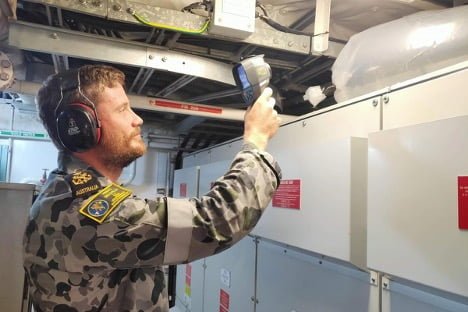By Lieutenant Simon Brown
Engineering innovation by technical sailors on board the Leeuwin-class hydrographic survey ship HMAS Melville has resulted in an increase in the maximum propulsion power available to support the ship’s involvement in task group operations, while improving the normal operating conditions for essential machinery.
The propulsion motor room (PMR) in hydrographic ships houses the ship’s main motors and gearboxes.
This equipment generates heat through its normal operation and the maximum propulsion output of the ship has previously been defined when operating in tropical climates by how effectively this heat can be dissipated.
Under the leadership and technical guidance of Petty Officer Marine Technician Ryan Schweitzer, the technical department in Melville recently investigated if the PMR could be cooled more effectively to allow the ship to operate its drive train at higher speeds.
A broad cross-section of the ship’s technical department was involved in thermographic mapping, airflow analysis and ambient air monitoring in order to prototype enhanced ventilation systems.
After testing and refinement of the enhanced ventilation system, analysis showed the enhanced design reduced the localised build-up of hot air around sensors and drive equipment.
This allowed the ship to achieve greater performance from its drive train, allowing Melville to travel at higher average speeds while giving the added benefit of reducing the load on the propulsion train when operating at lower speeds.
Commanding Officer HMAS Melville, Commander Michael Kumpis, applauded the marine technicians’ hard work.
“This is another great example of Next Generation Navy at work with our MT sailors challenging themselves to come up with innovative solutions to fix problems and take action,” Commander Kumpis said.
“Through those efforts, we have immediately enjoyed a positive impact on operations while ensuring our plant and equipment is effectively sustained for the long term.”
The improved ventilation allowed Melville to increase its maximum speed when conducting operations as part of Task Group 637.3.4 with HMA Ships Adelaide and Larrakia, providing a direct benefit to enhanced regional engagement activities with the local communities in Nuku’alofa, Tonga.
Engineering Officer Lieutenant Commander Jonathon Robarts said it was great to see the marine technicians in Melville were able to conduct a deep level technical investigation and produce tangible improvements using the ship’s organic capability.
“This is what a return on investment looks like when you invest in your people,” Lieutenant Commander Robarts said.
After receiving a technical report on the investigation drafted by Petty Officer Schweitzer, the Hydrographic System Program Office (HSPO provided cost-effective recommendations to fully implement a permanent solution.
Further trials have been conducted with ship staff, HSPO and British Aerospace engineering representatives working together to achieve significant efficiency improvements and reinforcing our sailors’ reputation as respected technical experts working in partnership with industry.
Petty Officer Schweitzer is planning to pursue a Bachelor of Engineering to become a marine engineering officer.
Australian Department of Defence
Featured Photo: Petty Officer Ryan Schweitzer taking a temperature reading during the prototyping phase of the ventilation system enhancement


